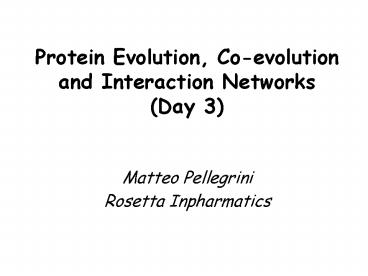Protein Evolution, Coevolution and Interaction Networks Day 3 PowerPoint PPT Presentation
1 / 38
Title: Protein Evolution, Coevolution and Interaction Networks Day 3
1
Protein Evolution, Co-evolution and Interaction
Networks(Day 3)
- Matteo Pellegrini
- Rosetta Inpharmatics
2
Protein Networks
Matteo Pellegrini Protein Pathways Inc.
3
Outline
- Introduction
- Methods to infer protein couplings
- Direct detection of protein-protein interactions
- Analysis of expression data
- Properties of protein networks
- Applications of protein networks
- Identifying genes involved in osteoclast
differentiation
4
Cells Contain High Concentrations of Proteins
that Participate in a Multitude of Interactions
Escherichia coli drawn to molecular scale
by David Goodsell
5
Types of Biological Molecular Network Models
- Models of molecular interaction networks may be
constructed at varying levels of resolution - Quantitative models use sets of differential
equations to model molecular concentrations - Qualitative models use graphs to represent
functional relationships between molecules
6
Quantitative Model EGFR Pathway
Ordinary differential equations include 94
state variables 95 parameters From Schoeberl B,
Eichler-Jonsson C, Gilles ED, Muller G.
Computational modeling of the dynamics of the MAP
kinase cascade activated by surface and
internalized EGF receptors. Nat Biotechnol. 2002
Apr20(4)370-5.
7
Qualitative Model 2-hybrid yeast protein map
1548 proteins 2358 interactions From Schwikowski
B, Uetz P, Fields S. A network of
protein-protein interactions in yeast. Nat
Biotechnol. 2000 Dec18(12)1257-61.
8
Advantages and Disadvantages of Different Network
Models
Quantitative Advantage allows for
quantitative predictions of perturbations on the
system Disadvantage requires an understanding
of the network connectivity as well as reaction
rates many parameters must be modeled per
interaction. These models are typically
constructed for small networks (lt 10 proteins)
Qualitative Advantage requires only the
understanding of network connectivity (1 bit per
interaction) Disadvantage leads to qualitative
not quantitative hypotheses
9
Qualitative Protein Networks May be Reconstructed
From Varied Data
Direct measurements of protein interactions
Analysis of co-evolving genes
Automated analysis of literature
Analysis of expression microarrays
10
Experimental Methods for Detection of
Protein-Protein Physical Interactions
- Physical Interactions
- Two hybrid
- Co-purification
- Protein Fragment Complementarity Assays
- Protein Chips
11
Database of Interacting Proteins (DIP)
12
Properties of Protein Networks
13
One Subgraph Typically Includes Most Nodes
Number of clusters
Number of proteins per network
14
Most Nodes are Connected by Short Path Lengths
15
Networks are Scale-free
16
Network Hubs Tend to be Proteins Essential for
Survival
17
Protein Networks Tend to have High Local
Connectivity
High Connectivity
Low Connectivity
18
Qualitative Protein Networks May be Reconstructed
From Varied Data
Direct measurements of protein interactions
Analysis of co-evolving genes
Automated analysis of literature
Analysis of expression microarrays
19
Applications of Expression Data Analysis
- Classification of experiments
- cancer diagnoses
- Classification of gene relationships
- find co-expressed genes
20
Degree of Correlation
The degree of correlation between two genes is
computed by the Pearson correlation coefficient
21
Conventional Analysis of Expression Data using
Hierarchical clustering
22
Challenges for Inferring Gene Relationships from
Expression Data
Extract correlations between genes from
correlated data sets
Experiment 2
Experiment 1
23
Correlations Between Experiments may be Removed
by Transforming Coordinates
Experiment 2
Experiment 2
Experiment 1
Experiment 1
24
Ergosterol Biosyntehsis Pathway in Yeast
According to KEGG
25
Recovery of Ergosterol Pathway using Yeast
Expression Data
26
Co-expression Among Ergosterol Genes in Untreated
Expression Data
27
Co-expression Among Ergosterol Genes in
Decorrelated Expression Data
28
Benchmarking Co-expression Data
29
Treating Rheumatoid Arthritis by Discovering
Genes Involved in T cell Activation
30
- T Cell Receptor (TCR) Signaling
- The immune response involves the recognition by T
lymphocytes of peptide fragments (antigens)
derived from foreign pathogens - This recognition event is mediated by the T cell
receptor (TCR) - This signaling cascade leads to the induction of
transcription of the IL-2 gene - T cell activation is implicated in autoimmune
diseases
31
T Cell Receptor (TCR) Signaling
32
Human Network
- Links are generated from the analysis of
literature, co-evolution and co-expression - 200,000 links between 20,000 human proteins
- Links are 70 accurate in recapitulating known
pathway associations - 30,000 links between 7000 proteins are supported
by multiple methods
33
Uncharacterized Receptor linked to T Cell Receptor
34
Experimental Validation of Computational
Predictions
T cell
Ionomycin (P/I) CD3/28
RNAi
IL2
35
Reduction of Receptor X mRNA leads to
upregulated IL-2 Production
siRNA
36
Receptor X Gene is Induced Following T Cell
Activation
Induced Gene of Interest Following T Cell
Activation
Jurkat
Peripheral CD4 Cells
CD3/28 P/I CD3/28 P/I CD3/28 P/I
CD3/28 P/I CD3/28 P/I CD3/28 P/I
CD3/28 P/I
______ 30m
______ 30m
______ 2h
______ 4h
______ 8h
______ 4h
______ 8h
37
Receptor X is a Putative Drug Target
- Orphan GPCR in rhodopsin family
- Coexpressed with TCR pathway proteins
- Target is upregulated upon TCR activation
- Reduction of target mRNA leads to upregulated
IL-2 Production - Novel drug would be an agonist to target causing
downregulation of TCR activation
38
Acknowledgements
- Michel Thompson
- Peter Bowers
- Kelly Oliner
- Seenu Kothakota
- Bill Boyle
- Steve Wickert
- Joe Fierro
- Darin Taverna
- Taruna Arora
- Marco Vasquez

